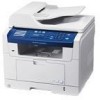Xerox 3300MFP Service Manual - Page 80
In Printing, the two procedures are, The additional printing function are realized
 |
UPC - 095205744415
View all Xerox 3300MFP manuals
Add to My Manuals
Save this manual to your list of manuals |
Page 80 highlights
Theory of Operation In Printing, the two procedures are ■ Using the USB Port a. When the user starts to print the desired document to a PCL or PS string, the Driver translates the all-graphic data and sends the data to the host spooler. The spooler then sends the data stream to the printer via the USB port. b. The Kernel receives this data from Host, and then select emulation fit to data and start selected one. After emulation job end, Kernel sends the output bit-map data to Engine using Printer Video Controller (by clock type for LSU). c. Engine print the received data to required paper with the sequential developing process. ■ Using the Network Interface Card a. When the user starts to print the desired document to a PCL or PS string, the Driver translates the all-graphic data and sends the data to the host spooler. b. The Port monitor managing the network port receives data from spooler, and sends a data stream to the Network Interface Card. c. The network interface card receives the data and sends it to the Kernel. d. The Kernel receives this data from Host, then selects an emulation that fits the data, and start the selected emulation. After the emulation job ends, the Kernel sends the output bit-map data to the Engine using Printer Video Controller (by clock type for LSU). e. The Engine prints the received data to the selected paper with the sequential developing process. The additional printing function are realized in (1) Web environment. (2) Window environment. In addition, the Kernel reports printing status and printer status with the Status Monitor. 2-38 Phaser 3300MFP Service Manual















